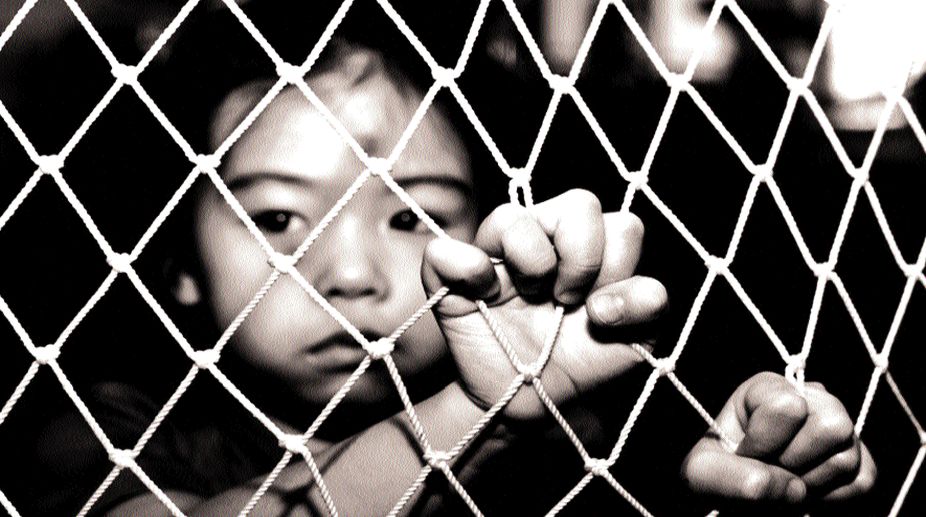Sankara Eye Hospital will remove darkness from people’s lives: PM
Prime Minister Narendra Modi Sunday inaugurated Sankara Eye Hospital and claimed that this hospital will remove darkness from the lives of the people and take them towards light.

Representational Image
Beyond civilisation’s reach works a whole other universe, not only resorting to dark ways but also pulling innocent children into it, depriving them of the happy life they deserve. The West Bengal Commission for Protection of Child Rights and International Justice Mission presented a horrifying picture of that universe while releasing a report on the commercial sexual exploitation of children in Kolkata. It was presented before the public by Ananya Chakraborti, chairperson, West Bengal Commission for Protection of Child Rights and Sanjay Macwan, regional director, IJM India.
Discussing the report in details, Macwan stated that the team of researchers went through a comprehensive nature of study trying to understand the scope of the crime. “For nine months the team walked into every possible public location like brothels and bars where girls are sold for sex out in open,” he said.
Advertisement
The other part of the research was on private establishments. “Since they operate in a covert manner, a different strategy was needed to track them. Thus to figure out the network, one must know and approach the trafficker personally and in the process determine the number of minor girls working under that network,” he explained.
Advertisement
A total of 4,143 sex-workers were documented from 451 public establishments and 131 sex workers from 40 private establishments. According to the study results, the prevalence of minors in public establishments are 0.8 per cent while those in private establishments are 18 per cent.
Quite contrary to the stereotypical notion of male-dominated exploiters and pimps, it was found that 80 per cent of contacts in private establishments were females. Their ages ranged from 16 to 58 years.
“We also tried understanding the victims and survivors’ profiles by listening to their experiences while being exploited under this crime. We tried to figure out how they were recruited and their movements regulated,” said Macwan.
77 per cent of children were defrauded with the promise of a good job before they were forced into sex work. The violence and trauma experienced led to the degradation of children into sexual commodities.
They were subjected to physical violence, multiple rapes and being groomed for the sex trade from the age of eight. Three survivors had witnessed murders of other sex workers as a warning against resistance. 55.5 per cent of the survivors said they were beaten with objects such as sticks and/or rods.
The children were found to provide sexual services to seven to 18 customers a day leading to incredible profits for the perpetrators. They earned between Rs1,200 -12,000 per day per victim while their annual revenues per victim ranged between Rs 3 to 4.5 lakh.
Macwan recommended that research on trafficking demands an organised approach. Given its covert nature, gathering evidence has become a challenge. High-end online investigation is required as mostly mobile Internet is used to buy the girls. Hence one must invest more in capacity building of the police force so that they can do pro active investigation. Collaboration between the states is also necessary.
According to Chakraborti, all law enforcing agencies, shelter homes and social activists must be a little compassionate in their dealings with the victims of trafficking. While working on trafficking as a documentary filmmaker, she saw that there is a definite lack of compassion in the whole process.
As an instance she stated one of her experiences while shooting a repatriation process of 13 girls from Bangladesh. The police came to fetch them and took them on a covered van where generally convicts are taken.
In the three hour journey, the police refused to stop the van and as a result the poor girls were deprived of food for the entire time. “They were not convicts but survivors of trafficking who had to go through a lot at a tender age and hence were traumatised.
They were returning home almost four-five years later and were tensed with the uncertainty of how they will be received by their family and society,” she said. When they reached Bangladesh, the shelter home that collected them, behaved in a similar inhuman manner.
Acknowledging IJM, Chakraborti said, “I salute IJM because it is the first NGO which was present in every police raid, shooting it, and made sure all the law was followed and the children weren’t abused. They have been doing this silently for many years.”
Advertisement
Prime Minister Narendra Modi Sunday inaugurated Sankara Eye Hospital and claimed that this hospital will remove darkness from the lives of the people and take them towards light.
A senior employee in the Delhi government’s Women and Child Development department is now facing child abuse charges after reportedly…
Smriti Irani was addressing the inaugural ceremony of the two-day Vatsal Bharat meet at Ravindra Bhavan in Bhopal organized for the states of Madhya Pradesh, Chhattisgarh and Rajasthan.
Advertisement
